|
Contents
117th Congress
You may have read media accounts that all the legislation introduced in the 116th Congress died as that session of Congress ended. This included H.R. 7151 – The Ports-to-Plains Highway Act, and H.R. 2 – Moving Forward Act in the U.S. House of Representatives, and S. 4701 – The Ports-to-Plains Highway Act in the U.S. Senate. These accounts accurately describe the legislative process. In order to be considered in the 117th Congress, new bills will need to be sponsored by both members of the Senate and House. The good news is that because of the work in the 116th Congress, the legislation has built a strong bipartisan foundation for legislation in the 117th Congress. Currently the Transportation Bill must be reauthorized by September 30, 2021.
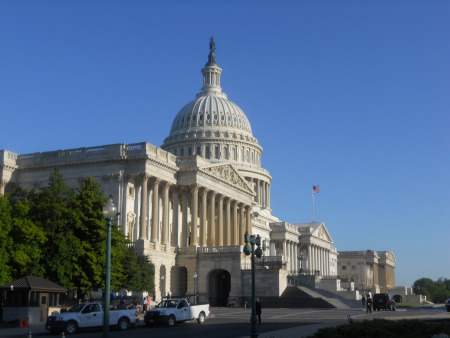
The priorities of the Ports-to-Plains Alliance are unchanged. The Alliance goal is to upgrade the entire 2,300-mile Ports-to-Plains Alliance Corridor from Mexico to Canada to a four-lane, divided highway or Interstate Highway capable of safely delivering the food, fiber and fuel that secure the quality of life of America's great cities. The Ports-to Plains Alliance supports—
- A multi-year reauthorization bill;
- A substantial increase in investment in the national transportation network;
- A long-term, sustainable fix for the Highway Trust Fund;
- Continued project delivery reforms to reduce the times for approvals and permitting; and
- Addressing disparities in rural transportation infrastructure to significantly improve safety and economic competitiveness in all parts of the country.
The Future Interstate Designation Legislation:
- Should designate entire Texas, New Mexico, Oklahoma and Colorado Ports-to-Plains Corridor and a portion of the Heartland Expressway in Colorado as a Future Interstate Highway.
- Should direct states to erect signs along the route identifying such route as future Interstate Route.
- Should ensure that vehicles that can legally operate on this portion of the Corridor today would be able to operate on the corridor once completed and opened to traffic.
There is still work to be done to further strengthen the bipartisan support for the Ports-to-Plains Corridor. While significant support will carry over, there are a significant number of new members that will need to be briefed on the importance of the Ports-to-Plains Corridor and its legislative priorities.
New Members of the U.S. House of Representatives
- Texas
- August Pfluger (R-11th)
- Ronny Jackson (R-13th)
- Tony Gonzales (R-23rd)
- New Mexico
- Yvette Herrell (R-2nd)
- Teresa Leger Fernandez (D-3rd)
- Colorado
- Montana
- Matt Rosendale (R-at large)
New Members of the U.S. Senate
- New Mexico
- Colorado
- Wyoming
Return to contents
Ports-to-Plains Alliance Board of Directors Election
Our Board of Directors is an all-volunteer Board. Congratulations to the board members which were re-elected to Two-Year Terms: 2021 - 2022.
- Brenda Gunter – San Angelo, TX
- Brad Bekkedahl – Williston, ND
- Deb Cottier – Chadron, NE
- Dan Pope – Lubbock, TX
- Coby Beckner – Clayton, NM
- Sid Cauthorn – Del Rio, TX
- Beverly Haggard – Lamar, CO
- Cathy Shull – Fort Morgan, CO
Return to contents
NDOT Awards L62A North Project on Heartland Expressway
The Nebraska DOT has let the L62A North Project on U.S. 385 within the Heartland Expressway. The award was made to Scott Contracting Inc. at just under $32 million with construction beginning by July 1, 2021. The project funding includes an $18.3 million federal discretionary INFRA Grant. The project will connect the four-lane divided highway completed in 2018 from Alliance south. The next project on the Heartland Expressway will be the U.S. 26 from Minatare to U.S. 385. NDOT has selected Alfred Benesch and Company as the design consultant.
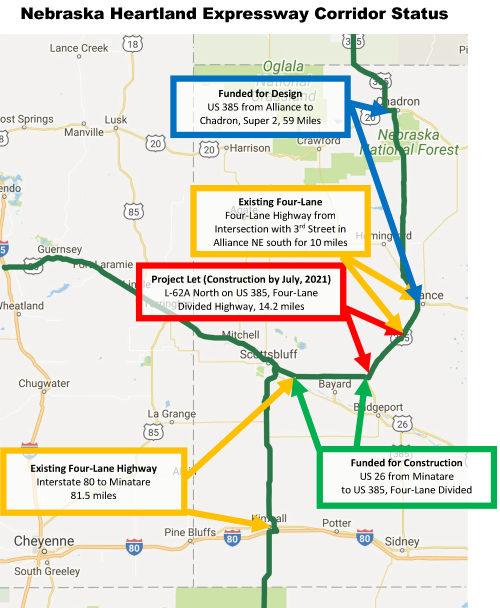
Return to contents
Texas-Mexico Border Transportation Master Plan
The Texas Department of Transportation (TxDOT) provided an update to the Texas Transportation Commission on December 10, 2020 on the Texas-Mexico Border Transportation Master Plan (BTMP). The purpose of the BTMP is to facilitate coordination and collaboration between Texas and Mexico on Texas-Mexico planning, programming, and the implementation of policies, programs, and projects (a) at border crossings and (b) support facilities and the multimodal transportation system that serves the Texas-Mexico border. The Ports-to-Plains Corridor serves three of the top eight border crossings on the Texas-Mexico Border: Laredo, Eagle Pass and Del Rio.
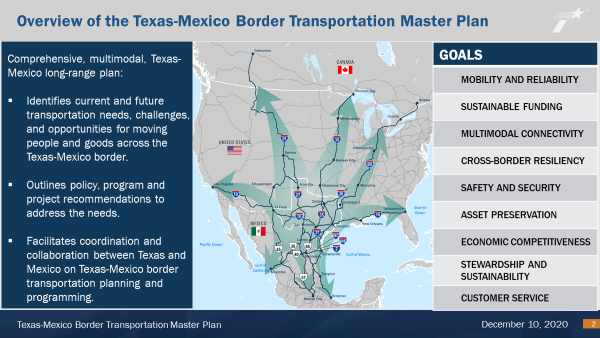
The movement of goods across the border touches all U.S. and Mexico states and generates over $343 billion annually in GDP - $200B in the U.S. and $143B as of 2019. This includes CMV (commercial motor vehicles), freight rail, aviation, maritime, and pipeline. This number is projected to more than triple to $1.2 trillion in GDP annually by 2050. Of this amount, CMVs represent the highest share of GDP contributions.
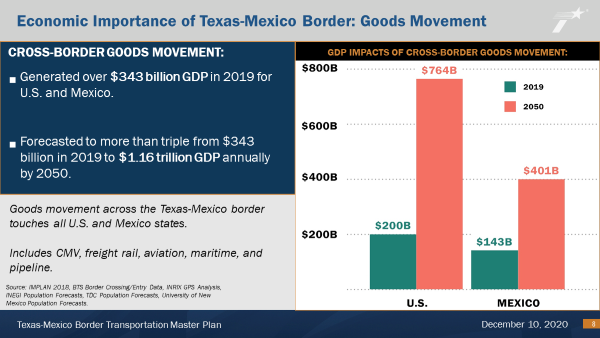
The number of northbound CMVs doubled between 1996 and 2019, increasing 112% from 2.1 million to 4.6 million. Between 2019 and 2050 the number of northbound CMVs crossing is projected to triple from 4.6 million to 12.4 million. The projected tripling in the number of CMVs crossing the Texas-Mexico border between now and 2050 will put additional pressure to the already congested border infrastructure. 81% of total trade crossing the Texas-Mexico border in 2050 (or $1.2 trillion) is forecast to be moved by CMVs.
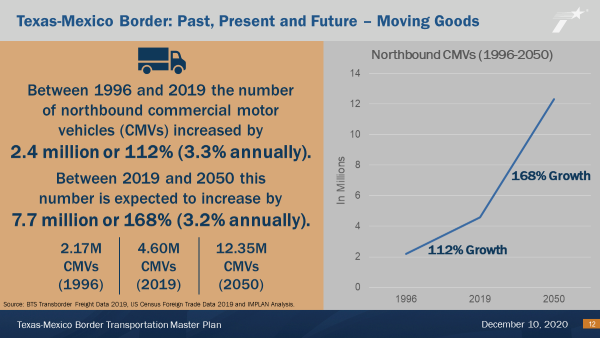
Border crossing volumes are forecast to increase significantly between 2019 and 2050, with transportation demand surpassing capacity. If no operational efficiency and system capacity improvements are made, delays are forecast to grow exponentially.

In 2019 there were $68.3 million in border delays. This results from1.6 million vehicle-hours of delay per year for goods heading northbound x $42.46 per hour in productivity losses. That is $210 per minute … $68.3 million per year / 365 days per year / 15 hours of goods movement per day / 60 minutes per hour.
By 2050, without improvements the cost of delays increases to 4.4 billion annually, reducing GDP by $116 billion. That calculates to $5,000 per minute = ($1.1B + $1.2 billion in GDP) / 365 days per year / 18 hours of goods and person movement per day / 60 minutes per hour.
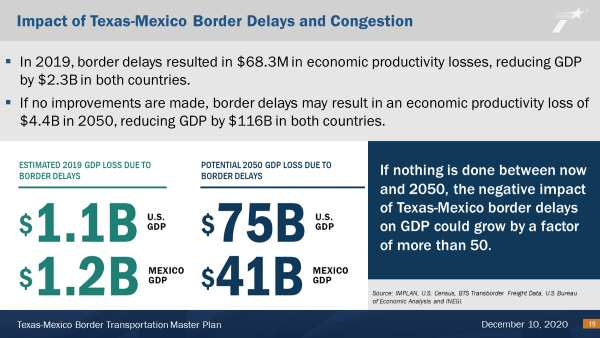
This Texas-Mexico Border Transportation Master Plan agrees with the Ports-to-Plains Interstate Feasibility Study, that Texas-Mexico Trade is critical to growth in population, employment, and income well beyond the border region. The implementing the recommendations of this plan will affect the economics of Agriculture, Energy, Manufacturing, and Distribution across Texas, the U.S., and Mexico.
Return to contents
Check out the newest Ports-to-Plains Video!
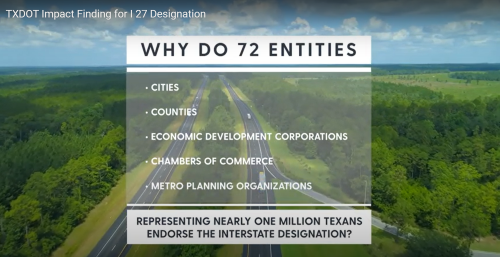
Click to View This Video
Return to contents
|